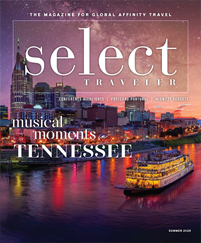Set on sprawling, spectacular grounds, the plantations of the South personify luxury and elegance. But more important than their grandeur are the links they provide to the past.
These five homes tell the tales of America’s first leaders, the war that turned brother against brother and how agriculture drove the development of the entire region.
Lansdowne Plantation
Natchez, Mississippi
Built in 1853, the Greek Revival mansion at Lansdowne Plantation is a rarity among historic homes not just in Mississippi but the entire South. Still occupied and owned by the descendants of George Marshall and Charlotte Hunt, the newly married couple who received the house and 600 acres surrounding it as a wedding present, Lansdowne has never been renovated. Instead, meticulous care has preserved most of the original furnishings and architecture, including marble mantels from Carrera and Egypt, and faux bois painting on the woodwork. The property features historic outbuildings, like a kitchen and a school room, too.
“Between the things that we have in our house,” said owner Marsha Colson, “and what happened in it — it was broken into by Union soldiers, for example — Lansdowne really tells the history of this area, which is one reason we opened it to the public in 1932. If you have a place like this and stories like these, you have to let people come in and see it and hear about it. Because experience and location really are the best history teachers.”
Once a working cotton plantation, Lansdowne now hosts groups year-round for tours, usually led by Colson herself.
“I talk about the house as it relates to the history of my family and the area, and the Civil War and what that was like for Natchez,” Colson said. “I’ve also portrayed my great-great grandmother, who stood up to the Union soldiers and got knocked down because she wouldn’t turn over the keys. If I know groups have certain interests, like the furnishings, I can talk more about that. I try to make it really meaningful for them.”
Houmas House Historic Estate and Gardens
Darrow, Louisiana
Perched on high ground overlooking the Mississippi River, the Houmas House offers groups the opportunity to explore an intoxicating melange of architectural styles dating back to the mid-18th century, when two New Orleans businessmen built the original French- and Spanish-influenced home on the site.
The current mansion was completed in 1840 in the grand Greek Revival style, featuring a stunning, three-story curved staircase. By the 1880s, the property had evolved into the largest sugarcane plantation in the South, comprising 300,000 acres. A half-century later, new owners redesigned the structure as a Williamsburg Federal style estate.
Purchased by preservationist Kevin Kelly in 2003, the Houmas House was renovated and opened to the public later that year. Because the home is privately owned, “we do not treat it like a museum,” said spokesperson Jesse Lambert. “Guests can sit on the furniture, play the piano and interact with our guides. The restaurants offer different experiences, whether it’s atmospheres, cuisine or price points. The inn consists of 21 cottages, each furnished and decorated with different furniture and artwork. The gardens are self-guided and replanted two times each year to offer full color year-round. Visiting Houmas House is not just a house tour; it really is an experience.”
Lambert said the staff “can almost always accommodate any group’s request. Houmas House can handle groups from 10 to 1,000 and offers a wide range of experiences, from cooking demonstrations and teambuilding exercises to formal teas, outdoor parties, galas and more.”
Charleston Tea Plantation
Wadmalaw Island, South Carolina
Groups don’t have to be tea drinkers to enjoy a visit to the Charleston Tea Plantation, especially when they take the Bill Hall Exclusive Tour with the company’s charming founder. The tours, which take up to 90 minutes, include a stop at the greenhouse and factory, a ride around the farm and plenty of history about not only the plantation itself, but tea as well. Hall’s team will order box lunches for groups, too, which they can eat under the property’s magnificent live oaks, with a view toward the plantation’s 60 acres of tea plants.
Hall purchased the property he would turn into the country’s only large-scale commercial tea operation in 1987 from Lipton Tea. Lipton had been conducting research and development on the farm, using cuttings from plants dating back to 1915, the last time a commercial tea operation had been attempted in the United States. In 2003, Hall, who learned tea tasting during a four-year apprenticeship in London, partnered with Bigelow Tea, although all the tea grown on the plantation is used exclusively in Charleston Tea Plantation’s nine flavors of tea.
Groups can count on plenty of fascinating facts about tea from Hall, who said one of the tidbits he most likes to share is “that there are only three types of tea in the world. There’s green tea, black tea and oolong tea, and they all come from the exact same plant. It’s how you make it that determines what of those three basic teas it’s going to be. Anything anyone asks about tea, I’ll know the answer to.”
Andrew Jackson’s Hermitage
Nashville, Tennessee
Nashville is about more than music, and groups visiting the city would do well to take time for a visit to the Hermitage, which provides an experience unlike any other, said Ann Dee Jones, the attraction’s vice president of marketing and communications.
“We’re the home of the seventh president,” she said. “And we’re the third-most-visited presidential site in the country. About 90% of the home and the artifacts in the home are authentic to Jackson and his time, so we’re one of the most well-preserved presidential homes as well.”
Jackson purchased the Hermitage site in 1804, though it wasn’t until a devastating fire 30 years later that the home was remade into the Greek Revival-style structure group visitors see today. In 1856, the state of Tennessee bought the Hermitage from Jackson’s heirs, eventually turning it over to a foundation to run as a museum. Along with Jackson’s tomb, the 1,120-acre property, home to 30 historic structures and a garden, hosts 230,000 visitors annually, including plenty of groups.
“Something I’m really proud of that we do is cater our tours to the groups’ needs,” Jones said. “If we have a group that’s particularly interested in horticulture and gardens, we can customize tours through our historic gardens with our gardeners. If we have a group that’s interested in a certain aspect of Jackson’s life, we can pull some of our interpreters to talk to them about that. I always love working with groups to find out what their niche is so that we can customize their experience.”
George Washington’s Mount Vernon
Mount Vernon, Virginia
There’s more to see at George Washington’s Mount Vernon than the home the first president’s father built in 1735, which Washington spent 50 years turning into an elegant 21-room mansion. Restored to its full glory, the building boasts historical interpreters in each room, but the rest of the estate beckons groups as well, offering more than a dozen outbuildings, including a blacksmith shop with daily demonstrations. Four gardens that total some six acres are also spread over the grounds, along with a four-acre farm and a Potomac River wharf.
In addition to farming and fishing, Washington was a superb whiskey maker. Groups can visit his grist mill and distillery, located three miles from the mansion. Washington, who died in his Mount Vernon bedroom in 1799, is interred along with his wife, Martha, in a tomb on the grounds. After groups pay their respects, they’ll want to head over to the museum and education center, which boasts an interactive theater and 23 galleries with numerous historical artifacts.
There are a number of exciting special programs available to groups at Mount Vernon, like opportunities to raise the flag at the main gate or attend a wreath-laying ceremony at Washington’s Tomb. Themed walking tours can be booked as well, or groups can break bread with folks like “Martha Washington; Washington’s granddaughter, Nelly Custis; Washington’s friend and personal physician, Dr. Craik; Washington’s farm manager, James Anderson; or another character from Washington’s world,” said reservations supervisor Argery Cooke. “Invite one of our talented character interpreters to greet your group at the Mount Vernon Inn. They can really liven up your dining experience.”









